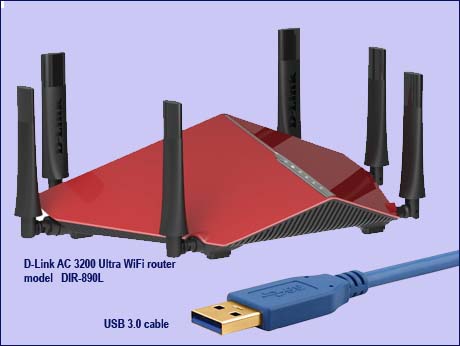
Tech Trend special: IT's time to shift to the newer, zippier WiFi standard codenamed 'ac' -- but make sure your connectors are USB 3.0
Bangalore, September 7 2015: Indians love a hearty eater. In another age, we queued to applaud the late S.V. Ranga Rao, who playing the role of Ghatotkacha in the 1957 Telugu-Tamil classic , Maya Bazar, demolished the Kaurava's Vivaha Bhojanambu or wedding feast. Today we are all gigabyte-gobbling Gatotkachas as we browse the Web, chat on WhatsApp, playing sudoku online, stream a YouTube movie -- and make a video Skype call. If we have linked our broadband connection to a home WiFi router, chances are multiple users in the family are doing all this simultaneously. And there's the rub.
The router provided by the cable or wireless data provider is usually the cheapest of its kind -- great for achieving the rated data speed when the technician does a Speed Test, but a washout, once a PC, a laptop and a couple of smart phones used by various family members, all latch on wirelessly to the same router. The promised download speed crashes to a tenth of what we paid for. Modern apartments --boxes of steel and concrete --are about the worst environment for data communication and the signal often fails to reach from front room to bed room.
When we pay anything from Rs 500 to Rs 2000 per month for a broadband connection it is sensible to just discard the 'free' router and spend some money on a device that makes our connection paisa vasool and reaches every room in our home.
Chances are your data cable guy has given you what is known as an N router -- one that measures up to the standard known as 802.11n ( the fourth generation after a, bc and g). It is almost 2 years since the 5th generation of the standard known as 802.11ac was established and AC routers as they are called, are easily available today. It is time to go for one. The peak data speed through an AC router is almost three times faster -- 1300 MBPS compared to 450 MBPS of the N router. Granted peak speeds are meaningless and real download speeds are around 100 MBPS with an AC router today, but this is still twice as fast as the best N router.
Of course, it is no use having the zippiest router if the data package you are subscribing does not measure up -- I would suggest going for a 50 - 100 MBPS for the home depending on your budget -- no more. About 6 months ago I decided to throw away the basic N router that was provided by my broadband subscription and go for an AC router. My Cable guy also advised me to go for one that operated in both the bands currently used 2.4 GHz and 5 GHz -- which is easily recognizable: there are two antenna sticking out of the router. After a lot of comparison shopping, I settled on the D-Link AC 750 dual band router paying around Rs 4000, not because it was significantly different from the others, but because this was the best deal at my neighbourhood Croma that week.
I could see a palpable difference in the reach and strength of my broadband connection but then our flat is quite small. If your home is an upstairs-n-downstairs duplex, and if your family members are serious downloaders, you have may look to look for an even better router. For a week I have been trying out a jumbo item in D-Link's catalogue -- the AC 3200 Ultra WiFi router model DIR-890L, seemingly a crossover product from large home to small office. This is --literally -- a heavyweight router -- weighing 1 kg and standing 10 cms tall , like a spaceship with 6 antennae. It offers one 2.4 GHz N band and 2 5 GHz AC WiFi bands, which means it can comfortably feed multiple PCs, laptops, tablets and phones. They call it a Cloud router because D-Link helps you set up a personal cloud to manage and monitor all devices using the router. I could smoothly stream a 4K YouTube movie clip from my phone to a 36 inch TV through a smart TV stick. When linking a PC do make sure that the Wireless Network Adapter you use to stablish the WiFi is also an AC device and not an 'N'... otherwise you will slow down the data transfer.
The DIR 890L costs Rs 18,500 which is about 5 times more than the cheapest dual band AC router. But for serious guzzlers it may be an essential culinary perquisite for a broadband bhojanam.
USB 3, is the key
The D-Link router described alongside is one of a new generation which sports both Universal Serial Bus or USB 2.0 and USB 3.0 ports. But to get the full benefit of USB 3, it is important to use a USB 3.0 cable and link to a USB 3.0 port on your device . Sadly, most PCs except the very latest still come with a USB 2.0 port. This defeats the purpose of investing in a high speed AC router with USB 3 port because when coupled with a USB 2 device, the speed degrades. Theoretically USB 3 is 10 times faster than USB 2 ( 4.8 GBPS versus 480 MBPS tops). Realizable speeds of data transfer are far slower but the ratio remains. Sadly we are stuck with whatever USB slot is provided on our PC, laptop or tablet -- if you do upgrade, remember to go for a model with USB 3.0.
If it works, it's obsolete, said media guru Marshall McLuhan. Already, USB 3.0 is being superseded by Superspeed USB 3.1 which is twice as fast as USB 3.0! - Anand Parthasarathy